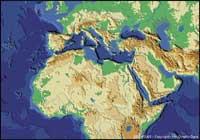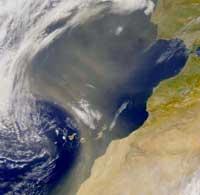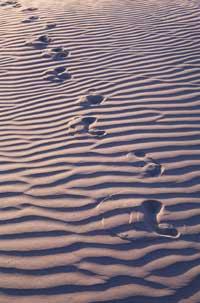The sand of the Sahara, source of rain

In many areas of Turkey and the Middle East in general water is as little as appreciated. Therefore, in order to control and appropriate this treasure, there have been several wars in these areas. Syria and Iraq need the waters of the Tigris and Euphrates rivers, which are born in the Turkish summits. The history of the peoples of the Middle East develops around water
About 5,000 years ago, humans decided to build villages in those lands. Until then, food was obtained from hunting and harvesting of plants, but thanks to adequate lands and climates on the banks of these rivers, peasant villages emerged. Mesopotamia was known as the "land between rivers" and, based on the exploitation of the two rivers that cross these lands, the Sumerian, Assyrian and Babylonian peoples became rich cultures and powerful empires.
For this purpose they learned to use the force of nature in their benefit. Taking into account the floods that were periodically produced, dams, dams and irrigation channels were built. In this way they managed to be one of the most advanced villages of the time. At the same time, the Egyptians and Chinese also built strong empires and the development of these two villages around rivers is very significant.
Over time, however, the strength of the Mesopotamians weakened and the lands were dominated by Greeks and Romans. Greeks and Romans, unlike the previous ones, based their power on the sea. The sea was not only a source of resources, but above all a way of cultural relationship and commercial exchange with other peoples. They became the largest in the Mediterranean and, thanks to the knowledge of the most advanced navigation systems, they could transport goods in a short time and everywhere. Since the lands of the Middle East remained very suitable for agriculture, both the Greeks and the Romans proposed their exploitation. In addition to the infrastructure built previously for the irrigation of the land, more dams and riverbeds were built.
"The next war will be for water"

In the Middle East there are still conflicts over water control, especially when the same source is in the hands of several countries. Water is historically a generator of problems and technological advances have made it a commercial issue that can be used to achieve economic and political objectives. In 1987 Boutros Gali announced that the next war would be for water. And it was not very wrong, because the relations between Turkey, Syria and Iraq are very deteriorated by the use of the waters of the Tigris and Euphrates rivers.
Turkey built a large dam in 1992, but the project it wants to carry out in the near future will probably aggravate the problem. The intention of the Turks is to build the "Canal de la Paz" to collect and sell the waters of the rivers Ceyhan and Seihan, which cross their lands.
It is clear, therefore, that water control is a priority for Turkey. Many of the areas of this country do not receive enough water and, for example, 30% of the energy used by Turkey is generated in hydroelectric plants, so in times of drought many areas are left without light. In addition, damage is observed in countries located in the lower course of rivers, especially in agriculture.
The "butterfly effect" or desert turned into a refrigerator

In the Middle East, no doubt, poor farmers and high-level scientists live under water and fear their lack. One of them is the Turkish researcher Cemal Saydam. He has sought the relationship between precipitation in his country and Saharawi residual dust. For this purpose, he collected on the one hand the snow measurements in the mountainous east of Turkey and, on the other, analyzed the movements of the residual storms. He compared the data and found that there was a relationship between them, checking the "butterfly effect".
According to the phenomenon known by meteorologists as "butterfly effect", the vibration of a butterfly's flight in the air, once multiplied by the atmosphere, can cause a high level change. Surprisingly, similar facts have been tested on several occasions. A clear example of this is that Saharian residual storms cause snow precipitation in the mountainous areas of Turkey. It seems that the clouds created in the Sahara, passing over the Mediterranean, accumulate humidity and, apparently, the residual dust increases rainfall.
Why is residual dust so good as a rain agent? To respond to this, the researchers used a special cold chamber. There, during the process of forming the snow crystals, the behavior of the grains of sand and the droplets of water was analyzed. And although it is known that the common dust generates ice crystals in the clouds, what was most surprising was that the residual Saharawi dust accentuates the speed of the process.

As popular knowledge says, quality is more important than quantity, and the rest of the Sahara meets this norm. The ice crystals that form them are four times higher than those formed by the common atmospheric dust. Consequently, rainfall is more intense and faster. In addition, they were able to determine the appropriate measures of temperature, humidity and residual particles to form ice crystals.
Now the Turks want to use to their benefit the exposed in the investigation. How? Once known the unique characteristics of the Saharawi sand powder, it is expected to be used in the sowing of clouds. They say they only need a few small planes. Satellites report the temperature and evolution of clouds, so they can know the most appropriate time. To avoid excessive rainfall, cold temperatures are expected to fall in the form of snow. And the Syrians and Iraqis have already spread their umbrellas.
CULTIVATION OF CLOUDS
One of the dreams of the human being has been to make the rain take place in the place and at the desired time or convenient. Formerly, the gods of heaven were prayed to provoke rain and the customs related to the rain fires are still preserved in many villages. In times when science has become god, man has made available to researchers and scientists the hope of making rain. In this way, once again, an attempt to dominate nature has begun and thanks to the sowing of clouds, the way to make artificial rain has been achieved.

Cloud sowing is not a new technique; almost 50 years ago Irving Langmuir, Nobel Prize in Chemistry in 1932, announced that he was able to control rain in the United States.
Although more than one method is known, the most used is the cloud introduction of some chemical that produces rain, such as silver iodide. The need for water is widespread, especially because of the needs of intensive agriculture, so a series of sessions are being held in many parts of the world. But the results are not as reliable as expected and also the sessions are expensive.
However, it has also been treated with other methods, and they say that the most successful is the one they tested three years ago in northern Mexico. At that time smoke was opened with a plane at the bottom of the clouds. This smoke contained particles that absorbed the water, which caused the drops of water from the clouds to gather up to one millimeter. Then they fell to the ground in the form of rain. According to the Meteorological Association of the United States, this method is very effective and plans to hold more sessions.
But what consequences does artificial rain production have? The fact of thinking that it can have a bad side effect on nature seems logical, so it would not be wrong to investigate.
Published in the supplement Natura de Gara
Buletina
Bidali zure helbide elektronikoa eta jaso asteroko buletina zure sarrera-ontzian











